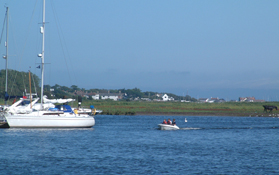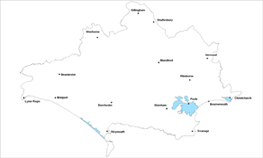Harbour / wetland / lagoon


Location
The Harbour/Wetland/Lagoon landscape type is found at the lower reaches of the Piddle, Frome and Stour river valleys forming Poole and Christchurch harbour and at the distinctive brackish Fleet lagoon west of Weymouth.
Key Characteristics
- a distinctive mix of tidal mudflats, marshland, reed bed, open water and shingle bank.
- indented and shallow shorelines to the harbours and the Fleet, which resemble large lakes.
- a large scale, open, tranquil and generally unspoilt landscape.
- provides an important range of habitats of significant conservation value.
- provides unique setting for the towns of Poole and Christchurch.
- important vistas and views of historic and cultural importance.
- unique and sensitive interrelationship with urban edges and the natural environment.
- provides important and popular open space and recreational value.
- many key features of interest such as Sandbanks Peninsular, Poole Harbour islands, Chesil Beach and Fleet shoreline, Poole Harbour Entrance, Mudeford Quay, Christchurch Priory environs and Hengistbury Head.
The Poole and Christchurch harbour areas of this type form a distinctive maritime harbour side landscape of indented shallow shorelines, open water, mud flats, marshland, winding creeks and reed beds in association with the urban edges to these two towns. The open water, marsh land/reed bed/mudflat areas have a low key, tranquil and undeveloped open character despite the proximity of the urban areas. An important mix of tree and other vegetation cover such as low lying marshes combines with and helps integrate adjacent urban edges. There are some distinctive and important historic urban views and landmarks such as Christchurch Priory overlooking the harbour and from the Fleet; the old chapel on top of St. Catherine’s Hill near Abbotsbury is a well known key landmark. A large proportion of this landscape type is designated as SSSI/SAC for its bio-diversity interest but it is also important for its landscape, open space and informal quiet recreational value. Chesil Beach is one the iconic landscape features along the south coast and its long slender shingle ridge forms an effective coastal buffer contributing to the tranquil character of the Fleet margins. These edges consequently resemble the edges of a lake with fields and hedges running down to its northern shores; Chesil Beach in contrast has a wild, natural and exposed feel.
Management Objectives
The overall management objective for the Harbour/Wetland/Lagoon Landscape type should be to maintain tranquillity, control development at the fringes to minimise its landscape, ecological and visual impacts, manage recreational use so as to conserve and enhance biodiversity interest, maintain key viewpoints and maintain undeveloped character. There are several key features which need their landscape setting to be conserved and enhanced such as Sandbanks Peninsular, Poole Harbour islands, Chesil Beach and Fleet shoreline, Poole Harbour Entrance, Mudeford Quay, Christchurch Priory environs and Hengistbury Head.
Key land management guidance notes
- reduce and control diffuse pollution in particular along the Fleet margins.
- promote/encourage appropriate rotational reed/marsh land management.
- control tree/scrub growth in marshland/reedbeds/saltmarsh.
- ensure any land drainage work is compatible with nature conservation objectives
- promote access management and appropriate interpretation initiatives at key entrance points.
- support the Chesil & Fleet Marine SAC and Poole Harbour Steering Groups.
- develop Urban Fringe Management Plans and/or partnerships to help control issues such as unauthorised uses/tipping.
- maintain the open, uncluttered and dramatic coastal landscape character of the area.
- identify and maintain tranquil areas for example by promoting and contributing to Harbour Management/Zoning Plans in particular.
- soften existing hard urban edges which erode character in places e.g. through small scale broadleaved native planting and/or via natural regeneration.
- conserve and enhance the undeveloped character along the coast.
- control the impact of coastal car parks and associated signage, markings and other ‘clutter’.
